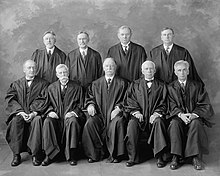Willis Van Devanter
Willis Van Devanter (* 17th April 1859 in Marion , Indiana ; † 8. February 1941 in Washington, DC ) was an American jurist , politician of the Republican Party , university teachers and more than 25 years of Supreme Court of the United States .
Life
Studies and promotion to judge at the US Court of Appeals
The son of a lawyer of Dutch descent studied after school first at Indiana Asbury College and then completed a postgraduate study of law at the Law School of the University of Cincinnati , which he graduated in 1881. After his licensing in the state of Indiana, he was an attorney with the law firm Lacey and Van Devanter Associate from 1881 to 1884 .
He later received a legal license in what was then Wyoming Territory and was prosecutor of Cheyenne , the capital of Wyoming , from 1887 to 1888 . After serving in the Wyoming Territory House of Representatives between 1888 and 1889 , he became President of the Wyoming Supreme Court in 1889. Between 1896 and 1900 Van Devanter was a member of the Republican National Committee , the national organizing body of the Republican Party.
He then was in 1897 at the beginning of the term of US President William McKinley assistant to the Minister of Justice ( Assistant US Attorney General ) and held that post during the presidency of Theodore Roosevelt from up 1,903th He was thus a close associate of Attorney General Joseph McKenna , John W. Griggs, and Philander C. Knox . At the same time he was during this time from 1898 to 1903 Professor of Law at George Washington University .
This was followed in 1903 by his appointment as a judge at the US Court of Appeals in St. Louis . He served until the end of 1910 at this eighth federal appeals court, which was responsible for Arkansas , Iowa , Minnesota , Missouri , Nebraska , North Dakota and South Dakota .
US Supreme Court judge
On January 3, 1911, he was appointed Associate Justice ( Associate Justice ) of the United States Supreme Court by President William Howard Taft and held that judge's office for more than a quarter of a century until his resignation on June 2, 1937.
While serving as a judge, along with Pierce Butler , James C. McReynolds and George Sutherland, he was nicknamed the Four Horsemen of the Supreme Court by the press because of their conservative attitude . Most recently, from the beginning of the 1930s, the four judges were also shaped by their bitter rejection of the economic and social reforms of the government of US President Franklin D. Roosevelt during the New Deal era . They faced the so-called Three Musketeers Harlan Fiske Stone , Louis Brandeis and Benjamin N. Cardozo , who were considered the liberal wing of the Supreme Court.
During his tenure, he took part in numerous important fundamental decisions such as Weeks v. United States (1914) or Meyer v. Nebraska (1923).
He was succeeded as Associate Justice at the Supreme Court after his resignation from the previous Democratic US Senator for Alabama and Chairman of the Senate Committee on Education and Labor Hugo Black .
Web links
- Willis Van Devanter in the nndb (English)
- Willis Van Devanter in the database of Find a Grave (English)
| personal data | |
|---|---|
| SURNAME | Van Devanter, Willis |
| BRIEF DESCRIPTION | American politician and judge |
| DATE OF BIRTH | April 7, 1859 |
| PLACE OF BIRTH | Marion , Indiana |
| DATE OF DEATH | February 8, 1941 |
| Place of death | Washington, DC |

